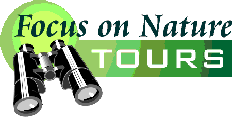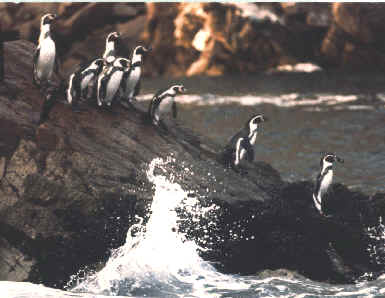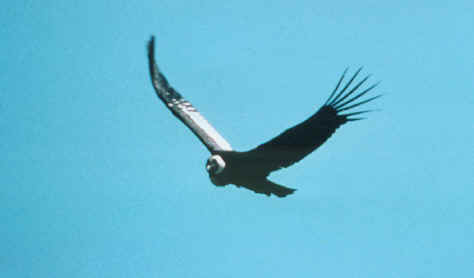
E-mail: font@focusonnature.com
Phone: Toll-free in USA 1-888-721-3555
or 302/529-1876
 |
PO
Box 9021, Wilmington, DE 19809, USA E-mail: font@focusonnature.com Phone: Toll-free in USA 1-888-721-3555 or 302/529-1876 |
A Focus On Nature Tour
 In CHILE
In CHILE
For Birds
and Other Nature
in a Beautiful Country
In Central and Northern
Chile
For
large and small
and unusual birds,
from
the sea
to the mountains
and in between.
Including the High Andes
at Nevados Tres Cruces
In 2016, our 22nd year for
a tour in Chile.
Among the birds:
Pintados
and other Petrels,
Albatrosses
(tours:
FON/CH-2 ’16)
February
15-24, 2016
in the
Andes, a Pelagic Trip,
and the Desert and High Andean Steppe
in Northern Chile
Tour to be led by Armas
Hill,
who has birded in Chile many times
since the first of all FONT tours,
which was in Chile in 1990.
Links:
A List & Photo Gallery of Chile Birds, in 2
Parts:
Part 1: Tinamous to Coots
Part 2: Thick-knee to Saltator
Chilean Albatrosses & Other Seabirds
Mammals of Chile (with some photos)
Amphibians & Reptiles in Chile & Argentina
The Diverse Plant-Life of Chile
Some Highlights from Previous FONT Chile Tours
A Feature with Some Poems
about Birds
by Pablo Neruda_(with
some photos)
Tour CH-2: in Central & Northern Chile
Mon: Feb. 15
Arrival
in the morning in
Santiago,
Chile
(after overnight flight departing North America, Sun, Feb. 14).
Birding during the afternoon up in the Andes
east of Santiago, where during our first day, we could well see Andean
Condors and one of the Chilean tapaculos known as the Moustached
Turca, in addition to various ground-tyrants and other birds of the
mountains including canasteros, miners, and earthcreepers.
Overnight in Santiago.
Tue: Feb 16 A visit this day to
the La Campana National Park, a UNESCO World
Biosphere Reserve. It is an area of mountains, valleys, and ravines in the
Coastal Range that is a good place for a number of species endemic to Chile,
not just birds, but also mammals, butterflies, amphibians
and reptiles, and plants.
In the park is one of the last remaining stands of wild Chilean Palms.
Among the birds: the Chilean Tinamou, Chilean Pigeon, Giant
Hummingbird, Chilean Flicker, Crag Chilia, White-throated Tapaculo,
Dusky-tailed Canastero, and the Rufous-tailed Plantcutter,
Mammals in the area include: the Culpeo and the Chilla (2
types of foxes), the Lesser Grison, and Degu.
Lizards in the area include: Mountain, Chilean, Schoeder's, Thin Tree,
and Wreath. Amphibians: the Helmeted Water Toad, and the Chilean
Four-eyed Frog (it doesn't really have 4 eyes, it just appears to).
Overnight again in Santiago.
Wed: Feb 17 We'll head to the Pacific
Coast, where birds will abound, including Inca Terns, Guanay Cormorants,
Peruvian Boobies, and Peruvian Pelicans, just to name a few, in
addition to penguins, gulls, shorebirds, and the endemic Chilean
Seaside Cinclodes.
Overnight near the ocean, following a nice dinner where those who wish can enjoy
some of Chile's renowned seafood.
Thu: Feb.
18
A morning pelagic birding trip, on the ocean
(to about 10 miles offshore). During such trips, as we've done many times
in the past, as many as 8 species of albatrosses have been
seen, in addition to numerous other pelagic species, including petrels, diving-petrels,
storm-petrels, and shearwaters. Not only will we see many
oceanic birds, we will see them close to the boat, as our chumming will attract
them well. (A complete list of the pelagic species seen
on these trips is available from FONT, or can be found elsewhere
in this web-site.)
In
the afternoon, we'll head north to La Serena,
where we'll spend the first of 2 nights.
Fri: Feb. 19
East of the interesting city of La Serena (Chile's second oldest city),
we'll enter, for the first time during the tour, Chile's desert
habitat where, once again, a number of the species of both fauna
and flora, flowering and otherwise, will be endemic to Chile.
Not an endemic species, but an endemic subspecies, the Burrowing Parakeet
occurs (one of only 2 relict populations in the country).
In the area east of La Serena, there a number of astronomical
observatories, as the night-time sky there in that dry area can not
be more clear.
For those who wish, we'll visit one of those observatories for an evening tour,
during which we could see, in the dazzling overhead sky: planets
(hopefully Saturn's rings), stars, and more stars in galaxies and clusters,
and some nebulae. Overnight in La Serena.
Sat: Feb. 20
In the morning, a visit
to Humboldt Penguin National Reserve, where we'll take a boat-ride to an island
4 kilometers offshore to see closely the penguins and other seabirds and marine
mammals, that could include dolphins, a sea otter, and a sea lion. Opossums
occur on the island's rocks where they feed on crustaceans. Green Sea Turtles
occur in the water.
Vegetation includes the Chilean cactus known as the Copipoa.
In the afternoon, we'll drive north to a city with almost the same name, Copiapo
(the letters are the same).
Overnight in Copiapo.
Sun: Feb. 21 From Copiapo,
we'll go east, ascending in elevation as we go into the high desert and the high
Andean steppe and the Nevados Tres Cruces National Park.
In terms of altitude, it will be our high point of the tour. And in a number of
other ways, the place should be a high point as well.
Saline lagoons and lakes, including the Laguna Santa
Rosa and the Laguna del Negro Francisco
are famous for their flocks of flamingos. And other waterbirds of
the Andes will be there too.
In the park, we'll be below the dormant stratovolcano complex of Nevado Tres
Cruces at 22,142 feet above sea level, and Ojos del Salado, the world's highest
active volcano at 22,615 feet. The scenery with the high mountains and the
blue-green Laguna Verde will be
stunning.
Among the common Chilean Flamingos, we should see the less-common Andean
Flamingo.
Among the common Giant Coots, we should see the less-common Horned
Coot. Andean Geese should also be in the area.
Mammals could include the two Chilean species of wild cameloids: the
more-common Guanaco, and the less-common Vicuna.
After a wonderful and full day, with birds, plants, and spectacular terrain, we
go back to Copiapo to spend the night.

An Andean Condor,
photographed by Alan Brady
during the first FONT tour in Chile in 1990.
Mon: Feb. 22 This day, we'll travel south from Copiapo back to La
Serena, for our last night there.
Along the way, we'll visit the Llanos de Challe
National Park, were the coastal mountains will certainly be lower
than where we were the previous day, and where the quebradas will open onto a
magnificent white sand beach aside the Pacific. Birds, butterflies, mammals,
reptiles, and plants should all continue to be of interest. Black-necked
Swans and Andean Condors could be among the birds. An amphibian could
be the Atacama Toad.
Tue: Feb.
23
This afternoon we'll be
back in Santiago. But in the morning, we'll visit an interesting place, the Fray
Jorge National Park, where, at higher elevation there is a relict Valdivian-type
forest with its accompanying plant-life, birds, and other nature. At a nearby
estuary, shorebirds aggregate. It will be a nice few hours, and our final foray
in the Chilean countryside before returning to the big city.
Wed: Feb. 24
From Santiago,
late-evening international flights departing Chile (arriving in North America the
following morning, Thu, Feb. 25).
![]()
Prices:
Tour
CH-2 (in Central & Northern Chile):
February 15-24:
US $2,995 per person.
Single supplement (when
available): US $395.
Includes:
All overnight accommodations.
Ground
transportation within Chile.
Meals: breakfasts & lunches (Feb 16-24)
The boat trips on the Pacific.
Services of an expert birding leader, familiar with the
birds and the localities.
Does not include:
Air transportation to/from and within
Chile.
Dinners.
Drinks and any items of a personal nature.
Airport taxes.
Gratuities.
A deposit of US $500
is required to reserve a place on this tour CH-2